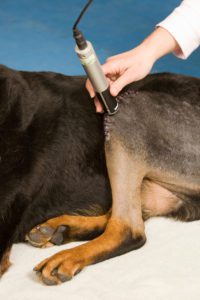What is Laser Therapy for Dogs and Cats?
Although the idea of laser therapy has been around for over a hundred years, it’s not something many pet owners have heard of. Laser therapy uses focused light tuned to specific wavelengths that allows it to focus into a powerful beam. Veterinarians in Warrick County, IN have begun using laser therapy for dogs and cats to treat a variety of conditions by using the deep-penetrating light bean to trigger a chain of chemical reactions, which is known as photo-biostimulation. This can relieve pain by triggering pain-relieving endorphins and promote injured cells to accelerate their healing.

After the first session, you will likely notice a positive change in your pet’s condition. However, depending on the severity of that condition, multiple treatments will need to be done before the Laser therapy reaches its full effectiveness. Laser treatment is a cumulative therapy, meaning the more often it is done, the greater improvement you’ll see in your pet. From start to finish, most laser therapies last between three and eight minutes, depending on the location of the treatment.
Your veterinarian will need to assess your pet’s condition and site of treatment before being able to devise an effective treatment plan. In general, your pet will require two to three sessions a week, and then will taper down to once a week, then once every few weeks. The equipment used in laser therapy is expensive, so treatment costs can run high, but laser therapy is a safe and non-invasive, less stressful way to treat chronic pain in your pet.
Laser therapy is also referred to as cold laser therapy, class IV laser therapy or low-level laser therapy. These are all the same thing, so don’t be confused by the varying terms. They all use the same equipment to stimulate cell regeneration and increase circulation in the affected area. It also can be used to decrease inflammation caused by infection or injury, allowing your pet’s body to heal faster and with less discomfort.
Laser therapy has been used to treat:
- Muscle injuries
- Tendon injuries or chronic tendonitis
- Ligament injuries
- Soft tissue trauma
- Post-surgical wounds and scars
- Gingivitis
- Skeletal injury or pain
- Hip or elbow dysplasia
- Hot spots (places where your pet keeps chewing or licking, to the point of injury)
- Open wounds
- Ear infections, specifically chronic ones
- Anal gland infections
- Degenerative disc disease
- Arthritis
Laser therapy can get a little warm but is not painful to your pet. In fact, many pets find the warmth of laser therapy so therapeutic and relaxing they decide to nap! Treatment can be adjusted to specific settings for your pet to reduce any discomfort.
All laser therapy treatment patient’s owners and providers must wear goggles during treatment to prevent the light from shining directly into anyone’s eyes, which can cause damage to the retina. Depending on your provider and what your pet prefers, goggles will be provided for your pet to wear. If your pet isn’t keen on the eyewear, their eyes can be covered by a blanket or towel, or someone can simply keep them from looking at the treatment process. Your pet will be permitted to sit, stand or even lay down depending on the location of the treatment site and what they find the most comfortable.
Laser therapy is an excellent way to provide temporary and long-term pain relief for your furry friend. The beam of focused light is used to promote vasodilation, or opening and widening of blood vessels, which reduces inflammation. It also activates the lymphatic draining system, which helps to drain any excess fluid from the area. This leads to a reduction of swelling and a reduction of pain. Laser therapy also stimulates nerve cells that block indicators that tell the brain there is pain and this lowers nerve sensitivity. Laser therapy can even encourage natural chemicals, called endorphins, that will alleviate more pain in your pet.
Post-operative laser therapy is now commonly used to accelerate healing on incision sites. Because the light can be focused on specific areas, it can trigger your pet’s natural healing processes and even enhance them by encouraging more blood flow and lowering inflammation. Laser therapy has been shown to strengthen muscles and tissues and improve your pet’s quality of life right away. There is no recovery or downtime needed after a laser therapy treatment session, so the minute your pet is finished with their visit, they will be as good as new – or even better than you’ve seen them in years!
There are no known risks of negative side effects connected with laser therapy for dogs and cats. Across the veterinary field, it is considered both safe and effective. Although it is relatively new in the veterinary industry, laser therapy has been used effectively on humans in a medical setting for nearly fifty years.
If you think Laser Therapy may be right for your pet, talk to your veterinarian about treatment options! Call Warrick Veterinary Clinic in Newburgh at (812) 853-6041 or Boonville at (812) 897-4855.
